Jesse James, American Outlaw
Jesse James was born on September 5th, 1847, in Missouri. He was the middle child of a Baptist preacher named Alexander James. (He had an elder brother named Frank, and a younger sister named Susan. Another elder brother, Robert, died in infancy.) Alexander was a hemp farmer in addition to being a preacher, and in Missouri at that time that meant that he owned several slaves. In 1850 he went on a mission to preach to the gold miners in California, where he caught pneumonia and died. His widow, Zerelda, remarried twice, the first time to another farmer who argued with her and was reportedly cruel to the James boys. They separated, though she didn’t remarry until after his death in a horse-riding accident. Her third husband was Dr Reuben Samuel, who would go on to give her four more children.

Missouri was a border state between the North and the South of the United States, and the edge of the states where slavery was legal. When the Civil War broke out in 1861, the majority of the state stood with the Union, but a sizeable minority (between 20 and 25%, judging by troop figures) sided with the Confederates. Naturally this made the state one of the early battlegrounds of the war. In August 1861 the Battle of Wilson Creek was fought in the state, and despite heavy casualties on both sides was an early victory for the Confederate forces. Frank James was a soldier in those forces, recruited by a local militia company. The Confederate victories continued for a while, but in late September the Union brought their main force to bear on the state. The majority of the Confederate forces were driven south out of the state, and nominal control of it passed to the Union. Frank James was not among those who left the state – he had fallen ill and was unable to travel. Taken prisoner, he was released once he signed a parole and allowed to return home. There he swore an oath not to raise arms against the Union. It was an oath he never intended to keep.
Though the Union supposedly controlled it, Missouri remained a state divided. Slave-owning families like the James knew they faced financial hardship if the Union lost the war, but more keenly they felt both anger at having the will of the national government forced upon them, and resentment at the implication that those they had enslaved would soon be allowed to stand as their equals. This sort of feeling led many ex-soldiers like Frank to decide to strike back at what they saw as an occupying army. They formed guerrilla units, who struck at Union targets and then faded back into the hills. Frank’s involvement became known to the authorities, who descended on the James farm looking for information on where his guerrilla troop could be found. They tortured Dr Samuels, but failed to get any information. The James family got off lightly – in some cases the relatives of known guerrillas were imprisoned. When one such prison collapsed in 1863, the guerrillas responded by descending on the small pro-Union town of Lawrence and murdering every man and boy older than 14 years old. Two hundred men and children were killed, and Frank James was (reportedly) one of those doing the killing. In retaliation the Union issued the infamous General Order Number 11, ordering the expulsion of all civilians from the four Missouri counties that were most sympathetic to the guerrillas.
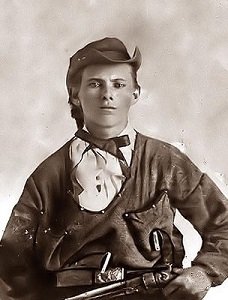
In 1864 the young Jesse left the family farm to join his older brother among the guerrillas. They served under “Bloody” Bill Anderson, one of the most notorious of the guerrilla leaders who became infamous when his men adopted the practice of scalping all the Union soldiers they killed. In the autumn, the James brothers took part in Anderson’s most notable success near the town of Centralia. The guerrillas blocked a railway and captured a train transporting Union soldiers on leave, who they took off the train and shot. When a Union troop in the town heard of the attack, they rode out in pursuit of the guerrillas. They were ill-equipped for this type of skirmish, however, and when they tried to form a firing line to face down the mounted guerrillas they were overwhelmed by a charge and slaughtered. Of 155 Union soldiers only 32 survived. Anderson was then ordered to continue to disrupt rail traffic, but instead he decided to terrorise the town of Glasgow, which had been captured by the Confederate forces. There he imprisoned the wealthiest of the local landowners, a Union sympathizer who had freed his slaves. Anderson and his men (possibly including the James brothers) tortured the man and raped the women among his former slaves, only releasing him once the local townsfolk collected a $5,000 ransom. As he was leaving Glasgow, word of his location reached Lieutenant Colonel Samuel P Cox. Cox had been ordered by the Union army to take a force and hunt down and kill Anderson. On October 26th 1864 his men caught up to the guerrillas. Anderson tried to repeat his tactics from Centralia, but Cox and his men were more experienced and better armed. Anderson was killed and his men, including the James brothers, fled. They split up, and continued to fight for different guerilla regiments until the end of the war.
Jesse was recovering from an almost fatal injury in 1865 when the war came to an end. He was in hiding at his uncle’s boardinghouse, and it was at this time that he began courting his cousin Zerelda (named after his mother). Outside his sickroom, Missouri was becoming part of the post-war Reconstruction. On paper this was supposed to be a time of healing, bringing the country back together. In practice, it became a chance to settle old scores. Anyone who had supported the Confederates were barred from public office, and many Northerners moved south to take over the offices that were thus left vacant, as well as lands that had been forfeited or lost by former slaveholders. (They were known as “carpetbaggers”, after the cheap luggage they were stereotypically said to be carrying.) The former Confederates felt alienated and abandoned, and this went double for the guerrillas who were marked men for the atrocities they carried out during the war. Many had been former bandits promised a pardon after a Confederate victory, and most went straight back to banditry. As soon as his injury had healed, Jesse became one of them.
Jesse was a bandit for several years, and was noted to have taken part in multiple holdups, but it wasn’t until 1869 that he and his brother became names in their own right. On December 7th they robbed the Daviess County Savings Association, and Jesse thought he recognised the cashier. He was a former Captain in the Union Army named John Sheets, but Jesse mistook him for Samuel Cox, the Colonel who had hunted down Bloody Bill. Jesse shot Sheets dead in cold blood, an act which resulted in a bounty being placed on his head for the first time. It also brought him to the attention of John Norman Edwards, a former Confederate Major who had been part of a group of soldiers (led by General Joseph Shelby) who had refused to surrender at the end of the war. Instead they had gone into exile in Mexico, with the plan of becoming mercenaries for the Emperor Maximilian. When that fell through he had come back across the border and gone to Kansas, where he wound up founding the Kansas City Times in order to campaign against both Reconstruction and black civil rights. He saw the potential of Jesse and Frank James as tools for propaganda, and so he reached out to them.
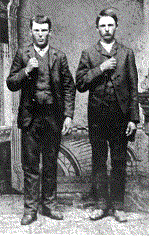
Edwards and the James brothers came to an agreement, and in May 1870 the Kansas City Times published a letter purportedly written by Jesse James declaring that he had been framed for the murder of Sheets. The letters became a regular feature in the paper, and painted Jesse as a fighter for the common man, standing up for their rights against the corrupt establishment. Edwards also referenced Jesse in his editorials as a true patriot, and did his best to make him a symbol of resistance against the Union. In truth, there’s no real evidence that James ever wrote any of the letters, and he definitely wasn’t above robbing people from all walks of life. He was definitely conscious of the value of having public support though, and when he and Frank joined a bandit crew led by fellow veteran Cole Younger, Jesse was the public face of the gang. The same aspect of playing to the public was on show when the gang took to robbing trains. They donned masks made famous as a potent symbol of Southern resistance to changing times – the distinctive headgear of the Ku Klux Klan.
Faced with these robberies, the train companies hired the Pinkerton Detective Agency to go after the “James-Younger gang”, as they were known. The Pinkertons had been founded by Allan Pinkerton, a Scottish immigrant who had led the Union intelligence services during the war, as a private security firm. Naturally they had little love for former Confederates, and the feeling was more than mutual. The Pinkertons sent an agent, John Witcher, to investigate the James brothers’ family home, the ranch of Reuben and Zerelda Samuels. He was found murdered, shot in the stomach and left to bleed out in the woods. That made it a personal vendetta for the Pinkertons. In response they staked out the ranch for several months and in January 1875 they staged a raid on it. They thought, mistakenly, that the James brothers had come home to visit their mother. They surrounded the farmhouse and, in an attempt to flush the outlaws out, threw “incendiary devices” through the windows. One of these crude devices exploded, killing Zerelda’s youngest child, a nine year old boy named Archie. Zerelda herself was badly injured in the blast and lost one of her arms. The whole incident led to a huge public outcry against the Pinkertons, tainting their name permanently in the South, and an increase in support for the James brothers.
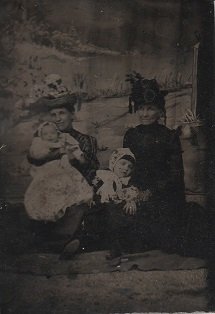
Though the Pinkertons were forced to back off, that was not the end to the James brothers’ worries. Both of them had married in 1874 (Jesse to his cousin Zerelda, and Frank to a young college graduate named Anne Ralston). This didn’t put an end to their criminal enterprises, but a disastrous attempt to rob a bank in Northfield, Minnesota would. The James-Younger gang rode into town on the 7th September 1876 in separate groups, in order to avoid drawing attention. Cole Younger later said that when he saw how crowded the town was he wanted to call the whole thing off, but it was too late. At 2pm they converged on the bank. One group guarded the entrance, one group guarded the escape route at the rear, and the two James brothers (along with Bob Younger) entered the bank. They drew their guns and tried to forced the three employees to open the safe. When the employees tried to lock them into the vault, they beat the cashier, Joseph Heywood and tried to force him at knifepoint to open the safe. He lied and told them there was a time lock on it. Meanwhile, the pair on guard outside the bank drew the attention of town residents, and when one of them stopped a man from entering the alarm was raised. Cole (who was on guard) and Clell Miller tried to panic the townsfolk by riding up and down the street, guns blazing, which drew the three men guarding the escape route to join them for backup. The owner of the local gunstore armed the citizenry, however, and they began firing on the five outlaws from cover. Two of them were killed, and the rest injured. Bob’s horse was also killed. On hearing the commotion the three in the bank fled, though Frank stopped to shoot Heywood dead as he left. The James brothers grabbed the remaining two horses, just as Cole ordered the gang to flee. Cole managed to get Bob (who had also been shot) onto his horse, and the surviving gang members fled. Only Jesse James escaped injury in the fusillade of gunfire.
The events at Northfield sparked a statewide manhunt. None of the surviving robbers knew Minnesota – only Bill Chadwell, who had been killed in Northfield, was familiar with the state. They continued to ride for the next week, stealing fresh horses and disguising themselves as a posse in pursuit of the “Northfield robbers”, but torrential rains and their widespread injuries slowed them down. Bob and Jim Younger were the worst injured, and by the 14th it was clear they could no longer keep up the pace. Cole decided to split the gang into two groups – the James brothers, who were in the best shape, would try to lead the posses off while the other group did their best to evade notice. This did initially work, and the brothers were able to draw the majority of the pursuers after them until they crossed the state line into South Dakota. However when Cole and his group stopped to buy food at a farm, the poor state of their gear made the farmer suspicious. He alerted the sheriff, who assembled a group of Civil War veterans into a posse to pursue the men. They were cornered in a wood, and in a final shootout the three Younger brothers were incapacitated, while Charlie Pitts, the other gang member with them, was killed. With the capture of the Youngers, the pursuit came to an end. Cole and Jim served 25 years in prison, while Bob died in jail of tuberculosis. The James-Younger gang was no more.
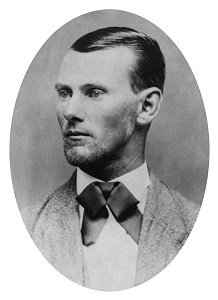
Jesse and Frank James went to ground, and there was no definite news of them for several years. Rumours constantly surfaced, including one that Jesse was the mysterious “Sim Jan” who led George Parrott’s [1] gang in 1878. Frank retired from his life of crime for good, but Jesse was unable to leave it behind. By 1879 he was definitely back on the “owlhoot trail”, robbing trains and post offices in Missouri and Alabama. Without the military experience that the ex-Civil War veterans had lent earlier gangs, his current crew were far less solid and dependable. Most were killed, or decided to quit the outlaw life. In the end Jesse James only had two members of his crew who he trusted, Charley and Robert Ford. Naturally they decided to betray him.
There was a $5,000 bounty on each of the James brothers, and the Ford brothers decided that their best hope of getting out of the outlaw life was by collecting the reward on Jesse. Robert Ford made overtures to the authorities, and was assured that he could collect the reward if he killed Jesse. On the third of April, 1882, he and Charley ate breakfast with Jesse. According to legend, when Jesse read in the paper that one of his other gang members had been arrested and realised that the Ford brothers hadn’t told him, he knew they planned to betray him. Rather than fire on them, he took off his guns, then climbed up onto a chair to straighten a crooked picture. While he had his back turned, Bob Ford shot him in the back of the head. It’s a poetic image, but one that probably owes more to Jesse’s romantic legend than actual fact. Regardless of the truth of the matter, it’s definite that he was shot in cold blood by the brothers, dead at the age of 34.
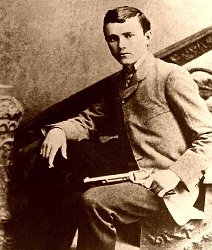
The Ford brothers surrendered to the authorities immediately, and were tried, convicted, sentenced and pardoned over the course of a single day. When they realised the strength of the public sentiment against them, they took a fraction of the reward they had been promised and fled. Bob Ford was eventually murdered ten years later in retaliation for his part in Jesse’s death. Frank James, on hearing of his brother’s death, immediately went to the governor’s office and turned himself in – on the understanding that he would not be extradited to Northfield. Instead he was held in Missouri, where he spent a year awaiting trial before being released due to a lack of evidence. He lived until the age of 72, and in his retirement he gave tours of the James family farm. Jesse’s son with Zerelda (also named Jesse) used his father’s fame as well – after spending some time working as a lawyer in Kansas city he moved to California in the 1920s and opened a restaurant called “The Jesse James Inn”. By that time Jesse had become a mythic figure – a symbol of Southern Pride, who went on to appear as a hero in dozens of Westerns. [2] In modern times the trend towards realism in historical dramas has tarnished his legend somewhat, with his portrayal by Brad Pitt in The Assassination of Jesse James by the Coward Robert Ford being his most high profile appearance in modern times. Too much truth, it seems, is the bane of all folk heroes.
Images via wikimedia.
[1] The same George Parrott who would be made into shoes by future governor of Wyoming John Osborne.
[2] When an aged sideshow performer in 1948 named J Frank Dalton claimed to be Jesse James, still alive after faking his death, the public desire for it to be true created such an outcry that the James family were forced to exhume Jesse’s body to prove him a liar.
